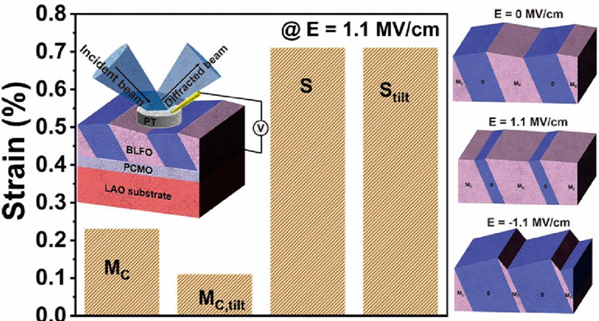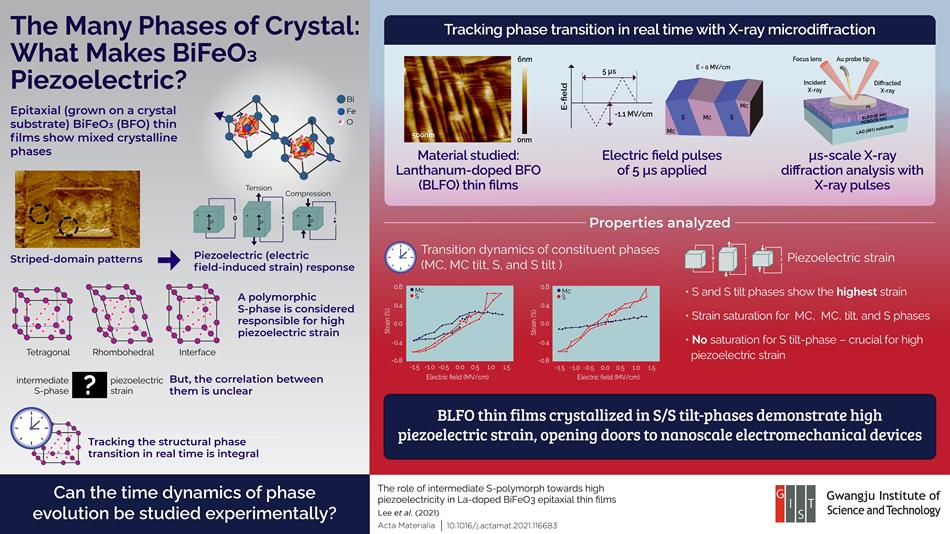Jun 29 2021
In a new study, researchers from the Gwangju Institute of Science and Technology in Korea have investigated the transformation dynamics induced by an electric field in mixed-phase lanthanum-doped bismuth ferrite (BLFO) epitaxial thin films. They observed a connection between the presence of S/Stilt phases in BLFO film and their high piezoelectricity. These findings can help us design faster and more efficient piezoelectric materials.
 Mixed-phase epitaxial BLFO thin film represents significant electric field-induced phase transformation dynamics, report scientists from the Gwangju Institute of Science and Technology. Image Credit: Ji Young Jo from the Gwangju Institute of Science and Technology
Mixed-phase epitaxial BLFO thin film represents significant electric field-induced phase transformation dynamics, report scientists from the Gwangju Institute of Science and Technology. Image Credit: Ji Young Jo from the Gwangju Institute of Science and Technology
What if electricity could be squeezed out of something? It turns out some materials have this property. Piezoelectricity is the electric charge that accumulates in certain solids when mechanical stress is applied on them. Piezoelectric materials, like bismuth ferrite thin films, when grown on a single lanthanum aluminate substrate give rise to highly strained epitaxial thin films that exhibit excellent electromechanical and ferroelectric properties. In bismuth ferrite thin films “doped” or polluted with lanthanum (BLFOs), piezoelectricity is attributed to the presence of “mixed-phase structures” with stripe patterns.
The formation of stripe patterns and controlling the mixed-phase structures of BLFO have been the focus of many studies over the years. But due to the ultrafast nature of phase transitions, the formation of energetically “favorable” phases under applied electric field and the origin of large electrochemical response has not been sufficiently explored. Many scientists engaged in research on BLFO are currently plagued by the question, what does the presence of an S-polymorph, an intermediate phase, do to the properties of the material?
Researchers at the Gwangju Institute of Science and Technology led by Prof. Ji Young Jo embarked on a journey to investigate the phase transformation dynamics of BLFO epitaxial thin films with the help of time-resolved X-ray microdiffraction. “We chose this technique because it helps us understand the electric field-induced phase transformation dynamics of the piezoelectric materials in a time scale ranging from picoseconds to microseconds,” explains Prof. Jo. The results of their exploration of the piezoelectric properties of BLFO films along with the identification of the mixed-phase structures and striped patterns were published in volume 7 (issue 116683) of Acta Materialia on 1 April 2021 and was made available online on 21 Jan 2021.
BLFO can be converted into monoclinic (MA, MC, tilted MC), tetragonal (T-phase), an intermediate S-phase, or mixed phases via strain engineering. The investigation into the transformation dynamics revealed that the phase change from Mc to S-phase were dependent on the polarity of the electric field applied. The study also concluded that the high piezoelectric response seen in mixed-phase BLFO films is due to the presence of S/Stilt phases.
“Understanding the role of stripe patterns and the S-phases can help us create ultrafast piezoelectric devices with a response time of sub-microseconds,” concludes Prof. Jo. The findings from this study provide a new perspective on the use of strain engineering to design ultra-high piezoelectric thin films. This has far-reaching implications for the future of energy harvesting.

Image Credit: Gwangju Institute of Science and Technology